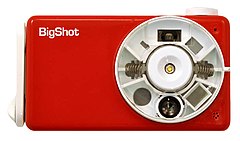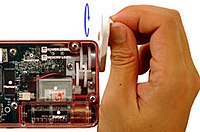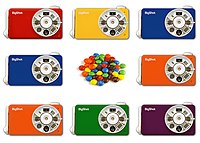Bigshot (digital camera)
Bigshot is a digital camera that serves as the centerpiece of the Bigshot Visual Learning Network, a global community of youth with an interest in cameras, photography, and shared learning. Created by Shree K. Nayar at the Columbia University Computer Vision Laboratory, both the camera and its accompanying educational network are geared towards global audiences between the ages of 8 and 14 years old. However, the network could be of interest to camera and photography enthusiasts of all ages. Bigshot combines unique digital camera technology, extensive online and in-person curricula, and a socially-enabled website.[1]
History/Inspiration
In 2004, Ross Kauffman and Zana Briski made the documentary Born into Brothels, an Academy Award-winning portrait of several children living in the red light district of Calcutta.[2][3] The filmmaker gave each child a camera and taught them photography so that they could begin to look at their world with a new set of eyes, unveiling hope and uncovering hidden talents from within themselves. As a result, many of them found the strength to break from their circumstances and begin charting out meaningful lives.
To Shree K. Nayar, the Director of the Computer Vision Laboratory at Columbia University who led the Bigshot project, Born into Brothels serves as compelling evidence that the camera is not merely a piece of technology but a device with profound social implications, since it could give us a powerful means to express ourselves, explore our own world, and perhaps most importantly, communicate with each other by sharing that world.[4][5] Moreover, as a piece of equipment that lies at the crossroads of science, technology, art, and recreation, the camera can serve as an exceptional tool for hands-on education in science, art, history, and culture.[5] Convinced of the potentially powerful impact that a camera explicitly designed for education could bring, Nayar launched the Bigshot project in 2006.[6] The first set of Bigshot cameras were produced for use in pilot workshops in 2009.
Design
As a camera designed for the purpose of education, Bigshot features several innovations that are not currently present in consumer market cameras.[1] Despite Bigshot's multi-year development cycle, many of the features in its current design originate from the very first conceptual sketch made in 2006.[7] For example, a circular wheel was conceived to have several lenses that could produce different types of images (the rectangles on the wheel are the viewfinder stencils that correspond to the different lenses). The dark spot in the middle of the wheel is the camera’s flash. A hand crank that can power the camera is on the camera's left.
Build-it-Yourself Kit
Unlike typical consumer-level cameras, Bigshot is designed as a simple set of building blocks that students can put together to assemble the camera themselves. A step-by-step set of instructions is featured in the Build section of the Bigshot website, and as students build the camera, they get a firsthand look at how the camera (and, by extension, other pieces of machinery and electronics) actually works.[8] Each building block can be used to teach important science and engineering concepts, and the Learn section of Bigshot's website was made to explore their connection to those concepts even further.[9][1] Since it was found too impractical to require students to solder the many electronic components together, the circuit board comes as a single pre-assembled building block.[7] However, the power generator, the flash module, and the lens wheel have mechanical parts that are easy to handle and assemble.
"Swiss Army" Lens
A key innovation in Bigshot is the polyoptic lens wheel, which is similar in spirit to the Swiss Army Knife™.[7][10] By simply rotating the wheel, the user can choose from a set of different lenses.[11] The three settings in the lens wheel are seen in the lower half of this sketch – normal view (small circle), panoramic view (large circle), and stereo view (rectangle).[12] The stereo optics is based on a design proposed by D-J. Kang, I. S. Kweon and R. Cippola in 1999.[13] Photos that are taken in the stereo setting can be viewed with red-cyan 3D glasses to appear three-dimensional.[7][14] The three rectangles seen in the upper half of the wheel are stencils that convey the fields of view captured by each setting to a person looking through the camera’s viewfinder.[15] The images captured by the wheel are distorted (or coded) and are processed by software to produce the final images.[7] In short, Bigshot is a computational camera.[7][16]
Kid-Powered Hand Crank
A unique feature of Bigshot is that it is designed to be “green.” Although it can be powered with a single AA battery, a human-powered generator is included inside so that it can continue to function if the battery is absent or if it runs out of charge during a photo shoot. The hand crank is coupled to a dynamo through a set of gears, and the resulting power that is generated by the dynamo is stored in a capacitor for use by the camera. About five rotations of the hand crank are enough to produce enough charge for the user to take a photo. Bigshot’s power generator exposes a student to mechanics and electromagnetism.
Playful Aesthetics
As with all of Bigshot's functional components, the look and feel of the camera itself was tailored to fit the student audience and educational theme.[7][5] Many shapes were considered for the overall design, but in the end a rectangular design with rounded edges was chosen to give the camera a soft, welcoming, easy-to-hold look. Bigshot's candy-like colors are similar to those of M&M's™, and the camera's transparent back cover exposes many of its electronic and mechanical components, allowing a student to (for example) show and explain how gears work while rotating the hand crank.[7][5][14]
Educational Scope
A core belief held by Bigshot's developers is that modern camera manufacturers have overlooked a large demographic in children and a compelling application in education.[6] They feel that consumer cameras are almost exclusively designed for, and marketed to, adults, and are usually densely packed with components and features. Furthermore, they believe that if a person were to try to disassemble a commercial camera to study its inner workings, it would be unlikely to function when put back together.[6] The Bigshot project seeks to overcome these obstacles and maximize educational impact by providing a three-fold approach to the use of digital cameras in learning environments. The Bigshot camera, along with its related educational materials, strives to support a cycle of 1) learning by building, 2) creating by using, and 3) expressing by sharing. Together, these experiences create the Bigshot Visual Learning Network, a global community of youth interested in engaging with Bigshot enthusiasts across cultures by building, using, and sharing.

Learn by Building

The camera hardware is presented as a build-it-yourself kit whose assembly promotes hands-on STEM education.[5][1] [17] Online materials support the building experience by demonstrating how to build the camera, and many additional online Bigshot resources extend the science and engineering topics being learned.[8][9][14] Collectively, this material inspires educators to create curricula connecting topics as diverse as art, science, engineering, and social engagement.[4][14]
An additional collaboration with Columbia University’s Center for Technology, Innovation and Community Engagement (CTICE) has resulted in the development and prototyping of supplemental curricular materials. These activities are being tested in after-school programs with New York City Public School students.
Create by Using

Once assembled, Bigshot can be used to explore the creative and communicative potential of photography. Community outreach workshops allow Bigshot's developers to explore ways that the camera might address the challenges of children in underserved communities with low access to technology.
One of the Bigshot project's principle aims is to grant underrepresented children creative access to photography as a medium for communication and expression. As of 2010, prototypes of the Bigshot camera have been used for extensive hands-on workshops in New York, USA, Bengaluru, India, Vũng Tàu, Vietnam, and Tokyo, Japan with almost 200 children.
Express by Sharing

The current Bigshot website includes a “Share” section featuring photo galleries of images taken by workshop participants.[18] Participants in field tests share their view of their world through online galleries, and they can view the galleries of other workshop participants from around the world through the site.[1] Bigshot developers continue to develop new means of encouraging global awareness and communication within the Bigshot user community through its website.[5][14]
Distribution
Bigshot camera prototypes are currently used in pilot workshops, which are being conducted at Columbia University and internationally. The cameras are currently not available for purchase.[19]
References
- ^ a b c d e "Students Can Build Digital Cameras, Focus On Science Lessons". NY1. 2010-01-21. Retrieved 2010-05-04.
- ^ "Born Into Brothels". Kids With Cameras. Retrieved 2010-05-03.
- ^ "Born Into Brothels". THINKfilm. Retrieved 2010-05-03.
- ^ a b "Little Camera, Big Idea". Columbia Record. 2009-11-04. Retrieved 2010-05-03.
- ^ a b c d e f "Bigshot Camera". Change Observer. 2009-12-10. Retrieved 2010-05-04.
- ^ a b c "Bigshot: Mission". Bigshot. Retrieved 2010-05-04.
- ^ a b c d e f g h "Bigshot: Design". Bigshot. Retrieved 2010-05-04.
- ^ a b "Bigshot: Build". Bigshot. Retrieved 2010-05-04.
- ^ a b "Bigshot: Learn". Bigshot. Retrieved 2010-05-04.
- ^ "Bigshot: Polyoptic Wheel: "Swiss Army" Lens". Bigshot. Retrieved 2010-05-04.
- ^ "BigShot Kit Camera, Like Crack for Kids". Wired. 2009-11-13. Retrieved 2010-05-04.
- ^ "Bigshot: Polyoptic Wheel: Introduction". Bigshot. Retrieved 2010-05-04.
- ^ Lee, D.H., Kweon, I.S., and Cipolla, R., "A Biprism-Stereo Camera System," CVPR, vol. 1, p. 1082, 1999
- ^ a b c d e "BigShot: Snap-together camera introduces kids to tech, and to their world". Christian Science Monitor. 2010-01-06. Retrieved 2010-05-04.
- ^ "Bigshot: Viewfinder and Eye: Viewfinder Stencil". Bigshot. Retrieved 2010-05-04.
- ^ "What is a Computational Camera?". Columbia Computer Vision Laboratory (CAVE). Retrieved 2010-05-03.
- ^ "Big Shot camera kit could help turn your kid on to the dark world of the teardown". Engadget. 2009-11-11. Retrieved 2010-05-04.
- ^ "Bigshot: A Camera for Education". Bigshot. Retrieved 2010-05-04.










